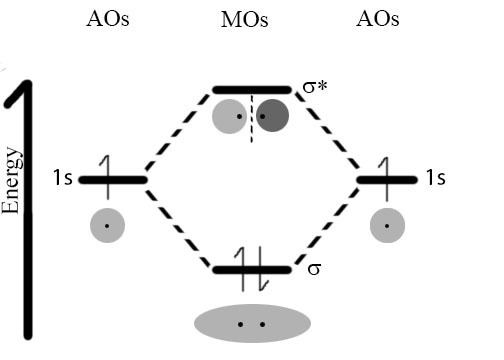 | ||
A diatomic molecular orbital diagram is used to understand the bonding of a diatomic molecule. MO diagrams can be used to deduce magnetic properties of a molecule and how they change with ionization. They also give insight to the bond order of the molecule, how many bonds are shared between the two atoms.
Contents
Molecular orbital theory is a model that demonstrates how electron interaction leads to bond formation. The motivation for this model comes from the electrons not being bound to a single bond, but instead influenced by the relative position of its nucleus within the molecule. The energies of the electrons are further understood by applying the Schrödinger equation to a molecule. Quantum Mechanics is able to describe the energies exactly for single electron systems but can be approximated precisely for multiple electron systems using the Born-Oppenheimer Approximation, such that the nuclei are assumed stationary. The LCAO-MO method is used in conjunction to further describe the state of the molecule.
Diatomic molecules consist of a bond between only two atoms. They can be broken into two categories: homonuclear and heteronuclear. A homonuclear diatomic molecule is one composed of two atoms of the same element. Examples are H2, O2, and N2. A heteronuclear diatomic molecule is composed of two atoms of two different elements. Examples include CO, HCl, and NO.
H2
Hydrogen is the simplest of the diatomic molecules as it only invokes the use of 1s orbitals. The superposition of the two 1s atomic orbitals leads to the formation of the σ and σ* molecular orbitals. Two atomic orbitals in phase create a larger electron density, which leads to the σ orbital. If the two 1s orbitals are not in phase, a node between them causes a jump in energy, the σ* orbital. From the diagram you can deduce the bond order, how many bonds are formed between the two atoms. For this molecule it is equal to one. Bond order can also give insight to how close or stretched a bond has become if a molecule is ionized.
O2
Oxygen has a similar setup to H2, but now we consider 2s and 2p orbitals. When creating the molecular orbitals from the p orbitals, notice the three atomic orbitals split into three molecular orbitals, a singly degenerate σ and a doubly degenerate π orbital. Another property we can observe by examining molecular orbital diagrams is the magnetic property of diamagnetic or paramagnetic. If all the electrons are paired, there is a slight repulsion and it is classified as diamagnetic. If unpaired electrons are present, it is attracted to a magnetic field, and therefore paramagnetic. Oxygen is an example of a paramagnetic diatomic. Also notice the bond order of diatomic oxygen is two.
Mixing
Mixing arises when the energy gap between the 2s and 2p orbitals is not very large. This leads to a mixing of the two orbitals that end in a repulsion. This repulsion causes a large enough shift in energy that the 2s σ* energy is lowered and the 2p σ energy is raised considerably. This is only a trend with the early elements, after oxygen the mixing ceases. The underlying cause for the mixing is the similarity in energies of the 2s and 2p orbitals in tandem with the same symmetry(gerade/ungerade). The early elements have such a low effective nuclear charge that they become prone to mixing. Oxygen is the first diatomic where the energy difference between the 2s and 2p orbitals is significant enough to neglect mixing. Next, we look at the N2 molecular orbital diagram and observe mixing of this nature.
N2
With nitrogen, we see the two molecular orbitals mixing and the energy repulsion. This is the reasoning for the rearrangement from a more familiar diagram. Notice how the σ from the 2p behaves more non-bonding like due to mixing, same with the 2s σ. This also causes a large jump in energy in the 2p σ* orbital. The bond order of diatomic nitrogen is three, and it is a diamagnetic molecule.
NO
Nitric oxide is a heteronuclear molecule that exhibits mixing. The construction of its MO diagram is the same as for the homonuclear molecules. It has a bond order of 2.5 and is a paramagnetic molecule. The energy differences of the 2s orbitals are different enough that each produces its own non-bonding σ orbitals. Notice this is a good example of making the ionized NO+ stabilize the bond and generate a triple bond, also changing the magnetic property to diamagnetic.
HF
Hydrofluoric acid is another example of a heteronuclear molecule. It is slightly different in that the π orbital is non-bonding, as well as the 2s σ. From the hydrogen, its valence 1s electron interacts with the 2p electrons of fluorine. This molecule is diamagnetic and has a bond order of one.
Notes
Molecular orbital theory, the more electronegative atom is the more energetically excited because it more similar in energy to its atomic orbital. This also accounts for the majority of the electron negativity residing around the more electronegative molecule. Applying the LCAO-MO method allows us to move away from a more static Lewis structure type approach and actually account for periodic trends that influence electron movement. Non-bonding orbitals refer to lone pairs seen on certain atoms in a molecule. A further understanding for the energy level refinement can be acquired by delving into quantum chemistry; the Schrödinger equation can be applied to predict movement and describe the state of the electrons in a molecule.
